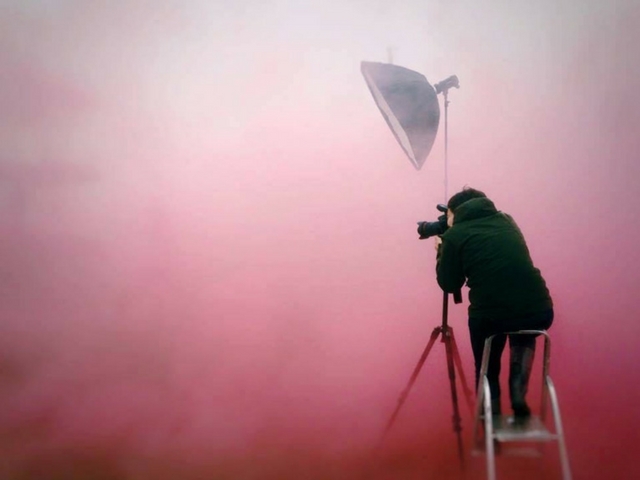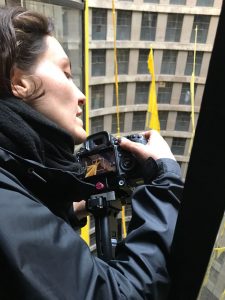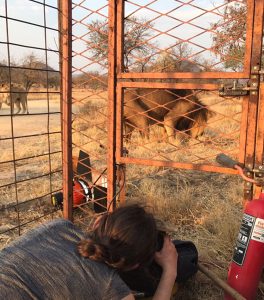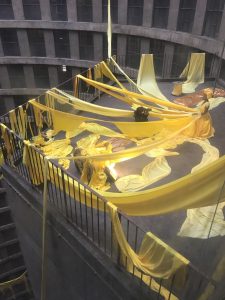When you were sexually abused, you drifted into a period of isolation. To anyone that hasn’t experienced this, is it possible to explain what that’s like?
It felt like being swallowed by an ocean of pain, in the middle of a storm, trying to get out without knowing the way up. I couldn’t explain it, I could only feel it and barely try to make it through the next minute. The world felt like a foreign place, and I was constantly detaching and having flashbacks. Given that it happened with someone in my family, it also unleashed a domino effect where many people I’d grown up with chose to stand by my abuser instead of me. They gradually removed themselves from social media without even talking to me about what had happened. It felt like a massive betrayal, and like all the good had been sucked out of the world.
You’re a cinematographer and photographer by trade. At what point did you realise your experience with a camera could help you combat what you were feeling?
I joined the YWCA Breakthrough Art Therapy program in Toronto, where I was living at the time. It was the first time I was asked to express trauma through art. We would work with clay, coloured sand, paint, fabrics, musical instruments. It brought out many images in my mind, but especially one, which became my own image in the Spiral book. I felt like I’d capture the image one day, perhaps in many years. Once I came closer to doing so, I wanted to involve others and started exploring the images they had in their minds. In some cases, I helped them interpret their stories in a way that resonated within them. I realised that cameras were the way forward for this project.
Your book Spiral started as a germ of an idea. What was it that allowed the project to evolve?
Once I started shooting The Spiral of Containment: Rape’s Aftermath, I realised that the few images I’d shot were each naturally attached to their own particular colour. It occurred to me that perhaps I could gather enough stories to go through the entire colour wheel, plus black and white. Each image could then become a chapter, with alternate angles and the survivor’s story within it. It’s due to the support of countless people, the survivors who chose to share their stories with me, and perhaps a certain amount of blind enthusiasm, that I’ve been able to keep it all going.
It can’t be easy to interview others who have suffered at the hands of abuse. What was your method for dealing with the interviews, and for creating the concepts for their photos?
I received support from a psychotherapist in order to create a chain of questions that might lead both myself and the other survivors to realising whether or not this was something they would benefit from. It was also important to determine if they were ready to do something that could potentially be quite triggering. My initial method was quite emotional, where I myself would be deeply connected to a person’s story and we at times bonded over a few shed tears. As the project evolved and I heard more stories, I became emotionally stronger. It helped me process my own past, and made me more able to manage their emotions, too.
I would always begin by exploring any colours, tastes, smells or images that might have stayed in their minds after the assault. It’s incredible the amount of material we would get from just that. Whenever a story affected me, I made sure to take some time that day or evening to just be still and cry if I had to, or write, or express whatever had been shifted within me. In the end, I always felt honoured that people had chosen to share their experiences with me, a complete stranger in most instances. It’s very humbling.
Your refuse to use the word “victim” and instead refer to the participants as “survivors.” Is that a reflection of how tough it is to come through the other side after an attack?
I refuse to be called a victim. The word itself makes my skin crawl. Many people have said that rape is not like a murder or a car crash or a fire, so why call it “survival”? I would argue that each of the people I’ve worked with have experienced a form of death through rape, whether it be the death of self, of childhood, of a person they had previously trusted, the emotional struggles that derive from the experience are huge. Dealing with flashbacks as you’re trying to cross a street or sit in a class, finding ways to become grounded and present, trying not to be a stranger to the world or a shadow to the people who once knew you, it’s a real battle. And though we might not have been to war as such, the journey itself is a true battlefield. So yes, I think “rape survivor” is adequate, and fair. Although being a survivor doesn’t mean everything’s in the past and won’t bother you again. The pain can resurface because the experience has changed you – perhaps not your nature, but the way you face the world and interact with people.
Was there any point you thought that the project wouldn’t be completed, and what were the greatest challenges?
MANY POINTS. Can I get a larger font for that? Ha! This project has faced challenges that, at times, I felt were greater than I could manage. Completing it has been a true lesson in the saying “impossible is nothing,” provided you’re willing to fight to make it happen.
I didn’t have the money to get it going at first, then one person believed in me enough to make it happen. I will never forget them for that. Then a few more people came on board and we managed to run a successful Kickstarter campaign. At many points during that process, I didn’t think we’d hit the target, and it was really stressful, working a full time job abroad to help pay the bills, and then essentially another full time job to make the crowdfunder happen. Working with different timezones and volunteers across five continents, asking for sponsorships, for locations, and also handling the emotional weight of the project – working with twenty-four other people who’ve suffered intense pain in their lives — at times the stories were hard to manage. At times, it was difficult to be strong for everyone involved. At times, I could have done a better job than I did.
It was hard when some people thought they were ready and then realised they weren’t. This happened once after we’d completed a shoot, so we cut it from the book. Another time, we had plane tickets to shoot in Switzerland where we’d found a free location that was perfect for the image we wanted, but we had to cancel the night before. That was definitely a low point. There’s nobody to blame. When you choose to work with a topic like rape, you need to understand that things will change. It’s an unpredictable landscape and people who think they’re ready might not be, so you need to learn to be flexible, think on the spot, and like any photography or film production, just roll with it.
What started as a small idea has now become a tangible product, a book that people can look at and hold. How does that make you feel?
I still haven’t had the chance to hold the book myself, which I think will be the moment when everything comes to life for me! For now, I’m still working hard to make the exhibition at the OXO Tower Bargehouse Gallery, which runs from 8-11th March 2018. The book will be available to buy for anyone who wants it. But just seeing the final PDF version, it felt a little hazy, like a dream. I think I still haven’t realised it’s real yet, but I do have fleeting moments of intense excitement.
“We need to realise that the solution lies not in a battle between women
and men, but as people united against a common evil.”
Are you surprised by how many people have suffered from sexual abuse?
When I first started, I was indeed surprised, but by now, I just expect that most people I meet, whether male or female, have experienced some form of sexual violence in their lifetime. I especially would like to draw attention to male survivors given that most campaigns and resources are aimed at women. Statistics are still astronomical for male sexual assault, and we need to realise that the solution lies not in a battle between women and men, but as people united against a common evil.
Do you genuinely believe that art can help deal with rape? And do your sentiments appear to be shared by the others in your book?
I believe that, for those of us who are artistically inclined, art is an unbelievably powerful medium to heal trauma. By no means do I believe that it’s the only way, but I do think it can help the healing process immensely. At times, it’s easier to express oneself with images or drawings than it is with words. Sometimes the body wishes to express through dance. I mean, every day we face the world, we’re expressing ourselves through our clothes, we choose the way we want to present ourselves to it. It’s a form of art. This is just taking that notion one step further and using it with a specific intention. I strongly recommend fellow survivors give art therapy a go. It really worked for me, and I’m sure it will work for many others as well.
We’re fast approaching your live art exhibition, which opens on World Day of Social Justice and runs from 8th – 11th March. Do people need to do anything to attend or just show up?
You can just show up, but we do also have an Eventbrite page set up that you can click on below, and it is really nice for us to be able to gauge numbers. So if you can take a minute to do that, it will be greatly appreciated. What’s more important though is that we see you there, and if you can help spread the word, all the better.
Every night, we’ll be holding panel discussions to address topics such as, “Does one bad deed erase all good ones?” and “Where is the line in today’s world?” We’ll also have some live music every night, so the event will be the same but different on any given evening. Come!
What do you think this project will help to achieve?
This project is one more wave in the sea of change we’re experiencing. It will help carry the movement forward, as well as open up the dialogue around rape. Considering the fact it happens to such a high number of the population, it has GOT to be a topic we bring to the forefront. No more hiding, no more silence. I also hope it will help us unite different genders and races to fight against what is a common evil. Viewing it any other way is a poison against humanity, and we must stand together to gain access to the antidote.
Everybody at Pen Works Media would like to thank Elisa for sharing her journey with us. It was only in December that we learned of her project, and turning such an important piece of work around in such a short space of time has been a challenge that we’re delighted to have been a part of. Our ethos has always been to produce work that challenges and alters people’s perceptions of the world, which is why we simply couldn’t resist the project.
Elisa has put her life on hold for four years to ensure this work was complete, and at great emotional and financial cost. Every book you buy really is going towards a wonderful cause, so please consider buying the book, attending the event, and helping to spread the word to your friends.
Buy Elisa’s book
Attend the Exhibition
Attend Preview Night (Press Only)
Download Press Release
Become an Event Sponsor
For any enquiries about Elisa or her project, please contact her agent Jody Medland in the first instance on jody@penworksmedia.co.uk.




